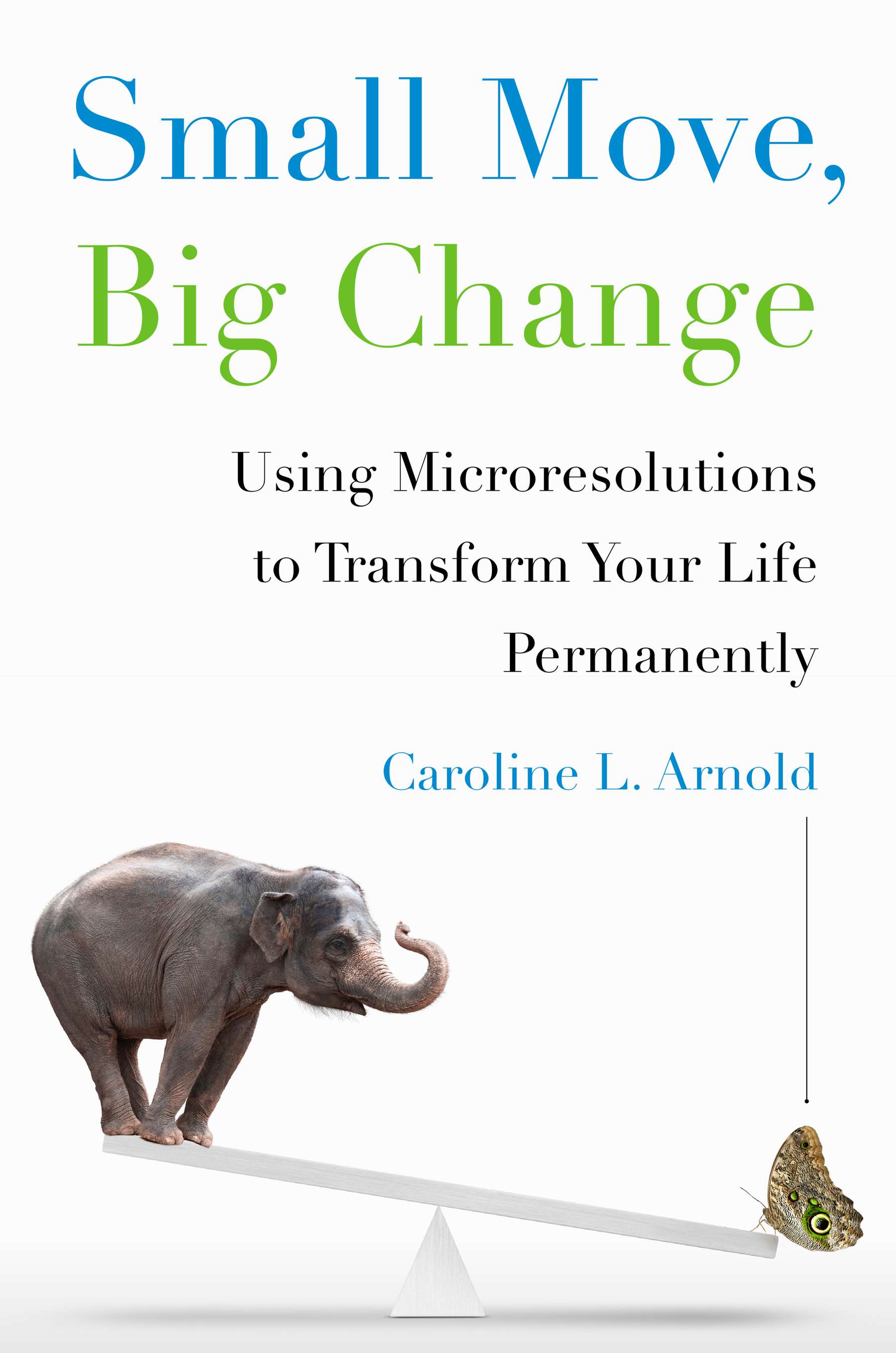From losing ten pounds to getting more sleep, Small Move, Big Change author Caroline Arnold shares how to set microresolutions to improve your quality of life.
1. Why do so many New Year’s resolutions go unresolved? How are microresolutions more effective than setting big goals?
Classic New Year’s resolutions such as to get fit, to be neat, to be on-time are really more like wishes than thoughtful resolutions to change behavior. We attack these goals with enthusiasm and determination, believing that we can transform ourselves from a couch potato to gym rat, from slob to neat freak, from perennially late to on-time in a matter of weeks. Ninety percent of us bail on our New Year’s resolutions by the second month, our willpower exhausted from trying to change too much too fast. When the next year rolls around, we’re likely to make the very same resolution, believing that this year will be “the year.” Because we seldom achieve our New Year’s goal, we remain focused on fixing ourselves “someday,” rather than on making progress every day.
In contrast, a microresolution is focused on a highly targeted behavioral change that is achievable today. Instead of vowing in the abstract to be organized, your microresolution might simply be to sort and cull mail before bringing it in the house, or to immediately add identifying contact information to the new phone number that just hit your smart phone. Either of these microresolutions would make you more organized now, today. Microresolutions overwhelmingly succeed because you channel your willpower against a narrow target. Microresolutions are made two at a time and are kept for a minimum four weeks to ensure they stick before new ones are added.
There’s a lot of starting, stopping, and restarting with New Year’s resolutions, where microresolutions are about continuous self-improvement.
2. What change in your life are you most proud of having accomplished through a microresolution?
This is a really tough question, because I’ve made progress in every area of my life through microresolutions. One microresolution that changed my life was a commitment to get myself ready for bed shortly after dinner, so that as soon as I started to feel tired or doze on the couch I could just stand up and walk off to bed, because my bedtime routine was already done, from pajama donning to flossing to phone charging. That one resolution resulted in about seven hours more sleep per week. Sleep is the most important ingredient in self-improvement, because when you’re fatigued you lose focus and your willpower fades more quickly. I devote a whole chapter to sleep in Small Move, Big Change.
3. Say I want to lose 10 pounds. What’s one small thing I can do every day, starting today, to get there?
Any discrete behavioral change that reduces your daily calories will lead to weight loss, as long as that new behavior becomes routine. The microresolutions you craft for yourself should be based on careful observation of your own eating behaviors. For example, one microresolution I made that was enormously effective was never to eat a conference room cookie again, because I worked in an office where rich cookies were often served in conference rooms. For someone else, a better microresolution might be only to eat off my own plate, eliminating all the extra calories that come with finishing off your kid’s food or eating half of your partner’s leftover dessert.
Here are some other ideas to get you thinking:
Many people eat another meal’s worth of calories after dinner in the run-up to bedtime. Making a resolution not to eat after 8:30 p.m. would save calories, likely get you to bed earlier (because we eat for energy), and the extra sleep itself would boost your weight loss efforts. This one was a game-changer for me.
Making a microresolution to savor food and drink (every bite, every sip) will give you a better chance to achieve satisfaction without overeating. The more quickly and mindlessly you eat, the less enjoyment you’ll experience, and the more likely you’ll be to overeat in search of greater satisfaction.
If you eat a cookie or candy bar every day around 3pm for a snack, making a microresolution to eat just half that snack will save you 100 calories a day, enough to lose 10 pounds in three years. If you want to lose 10 pounds this year, make second microresolution that will save you another 100 calories—such as resolving to use skim milk in coffee, passing on bread at dinner, or reducing your wine consumption by half a glass each evening.
Microresolutions work because they are designed to be sustainable forever. Better to lose five pounds that you keep off for life than fifteen pounds that you gain back in three months. By adjusting your behavior one or two microesolutions at time, you can remake your eating patterns so that weight control is managed on autopilot.
4. Where can our audience learn more about your book?
You can learn more about Small Move, Big Change and making microresolutions at smallmovebigchange.com where there are free resources and links to articles about the book that have already been published. Small Move, Big Change was named a best book of 2014 by Adam M. Grant (the author of Give and Take and by Inc. Magazine. The book is available at online booksellers now, and in independent bookstores across the country beginning January 16.
Posted on 2/5/2014
Caroline L. Arnold has been a technology leader on Wall Street for more than a decade, managing some of the financial world’s largest software development teams and leading some of the industry’s most visible and complex initiatives. A dynamic and engaging speaker, she has appeared before groups as large as 5,000 people. Arnold is a recipient of the Wall Street & Technology Award for Innovation for building the auction system for the Google IPO, and her name appears on technology patents pending. Arnold serves as a Managing Director at Goldman Sachs, a leading Wall Street investment bank.














Leave A Comment
You must be logged in to post a comment.